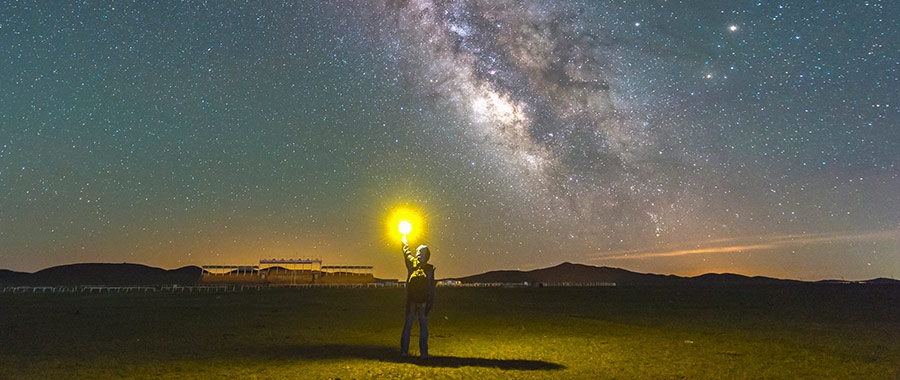The views expressed in our content reflect individual perspectives and do not represent the authoritative views of the Baha'i Faith.
What do prophecies mean generally? How can we best understand them?
We know that prophecies purport to be religious crystal balls, offering a glimpse into the distant future. But the glass is dark, murky, obscure. The glimpse is hazy, vague, bewildering—and subject to a wide range of interpretations.
Prophecies have been used to bolster the “prophetic credentials” of a messianic claimant, as fodder for revolutionary propaganda—or even as bewildering justifications for terrorism.
So let me answer the question about the real meaning of prophecies by briefly recounting how I began to seriously study them, and what I discovered in the course of my intellectual and spiritual odyssey.
Shortly after I first became a Baha’i on December 15, 1972, I became interested not only in how the revelation of Baha’u’llah fulfilled Christian prophecies, but how Baha’u’llah fulfilled the prophecies of other Faiths as well. Baha’u’llah, after all, claimed to be the “Promised One” of all religions:
… the Promised One of all the world’s peoples hath now been made manifest. For each and every people, and every religion, await a Promised One, and Baha’u’llah is that One Who is awaited by all; and therefore the Cause of Baha’u’llah will bring about the oneness of mankind, and the tabernacle of unity will be upraised on the heights of the world, and the banners of the universality of all humankind will be unfurled on the peaks of the earth. – Abdu’l-Baha, Selections from the Writings of Abdu’l-Baha, p. 101.
This monumental claim intrigued me. It launched me on a lifelong study of the apocalyptic and prophetic scriptures of the world’s religions. So, long story short, I wrote a book entitled, Zoroaster and the Mystery of the Great Reversal, which I characterized as a complement to William Sears’ classic Baha’i book, Thief in the Night, or, The Strange Case of the Missing Millennium, which marshals biblical proof-texts in support of the Bab’s and Baha’u’llah’s claims.
Zoroaster and the Mystery of the Great Reversal focused on Baha’i prophecy fulfillment in non-Christian religions. But over time, one could say that I graduated from the “search after proof” to the “search after truth.” How did this happen? At first, I would avoid reading books with footnotes. Then, I realized that the books with footnotes contained much more interesting and accurate information!
Here’s what I concluded: Apocalyptic texts are a form of crisis literature. They mean to instill and encourage perseverance, by the religious faithful, in times of persecution and oppression, and to inspire hope in future liberation, whether religiously or politically defined.
So the first requirement in understanding these vivid yet baffling texts is to appreciate their historical context, the shared mythology that prevailed at the time, and their grammar of images used as symbols, which worked as a kind of “secret code” that the readers could decipher, but would baffle any attempt at comprehension by others.
I also began to understand that prophecies are often recycled—their themes, motifs, images and cosmic dramas are adapted to new historical circumstances and reconfigured accordingly. For instance, the author of the Book of Revelation, or Apocalypse of St. John The Divine (which is the last book in the Bible) itself drew heavily from Old Testament prophets. This is more or less accepted as fact by consensus among New Testament scholars.
Not only are prophecies recycled, they establish narrative and rhetorical patterns that render them susceptible to fresh interpretations under vastly different historical and political circumstances. In this sense, prophecies are capable of more than one interpretation—where time and place make all the difference.
My ongoing investigation led me to understand and appreciate the use of “presentism” in the interpretation of prophecies. For many people, prophecies simply do not matter if they do not pertain to the here-and-now.
Throughout history, prophecies have typically been interpreted through the use of “presentism,” which the Oxford English Dictionary defines as follows: “A bias towards the present or present-day attitudes, esp. in the interpretation of history.” We can apply this mode of interpretation to prophecy as follows: “A bias towards the present or present-day attitudes, esp. in the interpretation of prophecy.” Presentism, generally speaking, interprets prophecies in terms of current or recent events.
So what do the Baha’i teachings have to offer in terms of understanding and interpreting prophecies? Rather than citing well-known instances of Baha’i interpretations of prophecy, it may be more useful to invoke the important Baha’i principle of the “harmony of science and religion.”
This might strike some readers as odd, considering the fact that science and religion have their own respective domains. What does science have to do with religion when it comes to religious texts? Well, it turns out that the “science” of the academic study of religion provides some very useful insights into the nature of prophecy.
The study of religion, strictly speaking, is not a science in the widely understood use of the term. But an important German term for the academic study of religion is Religionswissenschaft (“science of religion”). In brief, Baha’is may understand prophecies on at least three levels: (1) historical-contemporary interpretation; (2) the history of interpretation; and (3) Baha’i interpretation. All three may happily co-exist.
Let me give an example: In the Quran, a chapter called the Sūra of Yā Sīn tells a story that is often referred to as the Parable of the City. (See Quran 36:13–29.)
Abdu’l-Baha interprets this parable historically, by referring to an episode in Antioch in early Christian history. (See: Peter in Antioch—the Wisdom of the First Christians)
Baha’u’llah interprets the very same passage prophetically, where the three “envoys” are interpreted as the Bab, Quddus, and Baha’u’llah. (See: The Cradle of Christianity—and Islam)
Abdu’l-Baha’s interpretation is historical in nature. It more or less is consistent with what scholars refer to as the “preterist” or “contemporary-historical” (German: zeitgeschichtlich) interpretation, which most scholars today consider to be the essential starting-point in understanding the Book of Revelation, or other apocalypses.
Thus the principle of the harmony of science and religion allows for both “contemporary-historical” and “prophetic” interpretations of prophecy. The “contemporary-historical” method can, more or less, be considered a “scientific” approach, while the latter “prophetic” mode relates to prophetic truth-claims, which are a matter of faith.
Generally speaking, the Baha’i teachings say that scriptural interpretation should conform to “science and reason:”
… as the clergy did not grasp the meaning of the Gospels and did not comprehend this mystery (the resurrection of Christ), it has been claimed that religion is opposed to science, for among other things the ascension of Christ in a physical body to the material heavens is contrary to the mathematical sciences. But when the truth of this matter is clarified and this symbol is explained, it is in no way contradicted by science but rather affirmed by both science and reason. – Abdu’l-Baha, Some Answered Questions, newly revised edition, p. 119.
















Comments
Sign in or create an account
Continue with Googleor